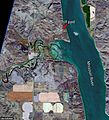Dakota Access Pipeline protests facts for kids
The Dakota Access Pipeline protests were big movements that started in early 2016. People used the hashtag #NoDAPL to talk about them online. These protests happened because a company called Energy Transfer Partners planned to build a long oil pipeline.
The pipeline was going to carry oil from oil fields in North Dakota all the way to Illinois. It would cross under important rivers like the Missouri and Mississippi. It would also go under part of Lake Oahe, which is very close to the Standing Rock Indian Reservation.
Many people from the Standing Rock tribe and nearby communities were worried. They believed the pipeline, especially where it crossed under the Missouri River, could pollute their drinking water. It could also harm the water used to grow crops. People also felt the pipeline would damage very old burial grounds and special cultural places important to their history.
During these protests, nearly 500 people were arrested.
Contents
What Was the Dakota Access Pipeline?
The Dakota Access Pipeline, often called DAPL, is a very long pipe built underground. Its main job is to carry crude oil, which is oil taken straight from the ground. This oil comes from the Bakken oil fields in North Dakota. The pipeline carries it across several states to Illinois. From there, the oil can be sent to other places.
Pipelines are often used because they can move large amounts of oil or gas over long distances. They are usually buried underground.
Where Did the Pipeline Go?
The pipeline stretched for about 1,172 miles (1,886 kilometers). It started in North Dakota and went through South Dakota, Iowa, and finally ended in Illinois.
A big part of the pipeline's path was planned to go under Lake Oahe. This lake is a large reservoir on the Missouri River. It is very close to the Standing Rock Indian Reservation.
Why Did People Protest the Pipeline?
People protested the Dakota Access Pipeline for several important reasons. These reasons were mainly about protecting the environment and respecting Native American rights.
Protecting Water Sources
One of the biggest worries was about water. The pipeline was designed to cross under the Missouri River and Lake Oahe. These are major sources of drinking water for the Standing Rock Sioux Tribe and many other communities. People were afraid that if the pipeline ever leaked, oil could spill into the water. This would make the water unsafe to drink and harm the environment.
The water from these rivers is also used to irrigate, or water, farmlands nearby. A spill could damage crops and affect people's ability to grow food.
Protecting Sacred Sites
Another major concern was about sacred land. The Standing Rock Sioux Tribe said that the pipeline's path would go through areas that were very important to their culture and history. These areas included ancient burial grounds and other sacred sites. They felt that building the pipeline there would disrespect their ancestors and their heritage.
Native American tribes have a deep connection to their land. They believe these sites should be protected and left undisturbed.
Who Was Involved in the Protests?
The protests were a grassroots movement. This means they started with ordinary people, not big organizations or governments.
The Standing Rock Sioux Tribe
The Standing Rock Sioux Tribe led the protests. They were directly affected by the pipeline's route. They organized many of the early actions and brought attention to their concerns.
Water Protectors and Supporters
Many different groups and people joined the protests. They called themselves "water protectors." This included:
- Members of other Native American tribes from all over the country.
- Environmental activists who care about protecting the Earth.
- Human rights activists who believe in fairness and justice for all people.
- Veterans and other concerned citizens.
People came from all over the world to support the Standing Rock Sioux Tribe. They set up camps near the pipeline's path to show their opposition.
What Happened During the Protests?
The protests involved many peaceful actions. People gathered, marched, and held ceremonies. They wanted to raise awareness and stop the pipeline's construction.
Peaceful Gatherings
Thousands of people gathered at camps near the construction site. They held prayers, shared stories, and learned from each other. These camps became places of community and resistance.
Marches and Rallies
Protesters also organized marches and rallies in many cities across the United States and even around the world. They carried signs and chanted slogans like "#NoDAPL" to show their support for Standing Rock.
Government and Legal Actions
The Standing Rock Sioux Tribe also tried to stop the pipeline through legal actions. They filed lawsuits in court to challenge the permits that allowed the pipeline to be built.
The protests continued for many months, drawing a lot of attention from news media and people worldwide.
Images for kids
-
Solidarity rally in Saint Paul, Minnesota, September 2016.
-
Standing Rock solidarity march in San Francisco, November 2016.
-
Native Nations Rise march in Washington D.C., March 2017.














